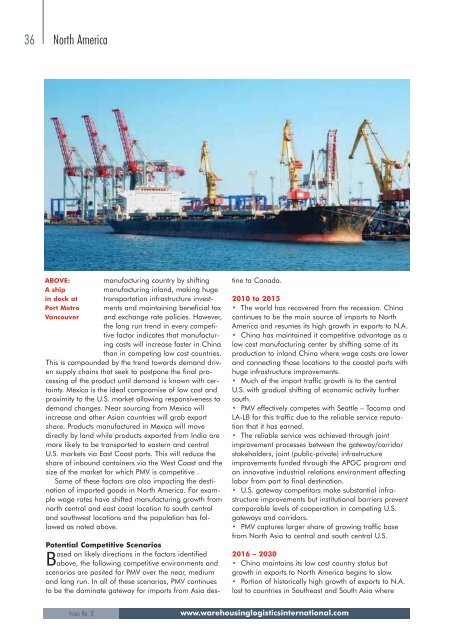ifwla - Warehousing and Logistics International
ifwla - Warehousing and Logistics International
ifwla - Warehousing and Logistics International
Create successful ePaper yourself
Turn your PDF publications into a flip-book with our unique Google optimized e-Paper software.
36 North America<br />
ABOVE:<br />
A ship<br />
in dock at<br />
Port Metro<br />
Vancouver<br />
Issue No. 3<br />
manufacturing country by shifting<br />
manufacturing inl<strong>and</strong>, making huge<br />
transportation infrastructure investments<br />
<strong>and</strong> maintaining beneficial tax<br />
<strong>and</strong> exchange rate policies. However,<br />
the long run trend in every competitive<br />
factor indicates that manufacturing<br />
costs will increase faster in China<br />
than in competing low cost countries.<br />
This is compounded by the trend towards dem<strong>and</strong> driven<br />
supply chains that seek to postpone the final processing<br />
of the product until dem<strong>and</strong> is known with certainty.<br />
Mexico is the ideal compromise of low cost <strong>and</strong><br />
proximity to the U.S. market allowing responsiveness to<br />
dem<strong>and</strong> changes. Near sourcing from Mexico will<br />
increase <strong>and</strong> other Asian countries will grab export<br />
share. Products manufactured in Mexico will move<br />
directly by l<strong>and</strong> while products exported from India are<br />
more likely to be transported to eastern <strong>and</strong> central<br />
U.S. markets via East Coast ports. This will reduce the<br />
share of inbound containers via the West Coast <strong>and</strong> the<br />
size of the market for which PMV is competitive .<br />
Some of these factors are also impacting the destination<br />
of imported goods in North America. For example<br />
wage rates have shifted manufacturing growth from<br />
north central <strong>and</strong> east coast location to south central<br />
<strong>and</strong> southwest locations <strong>and</strong> the population has followed<br />
as noted above.<br />
Potential Competitive Scenarios<br />
Based on likely directions in the factors identified<br />
above, the following competitive environments <strong>and</strong><br />
scenarios are posited for PMV over the near, medium<br />
<strong>and</strong> long run. In all of these scenarios, PMV continues<br />
to be the dominate gateway for imports from Asia des-<br />
tine to Canada.<br />
2010 to 2015<br />
• The world has recovered from the recession. China<br />
continues to be the main source of imports to North<br />
America <strong>and</strong> resumes its high growth in exports to N.A.<br />
• China has maintained it competitive advantage as a<br />
low cost manufacturing center by shifting some of its<br />
production to inl<strong>and</strong> China where wage costs are lower<br />
<strong>and</strong> connecting those locations to the coastal ports with<br />
huge infrastructure improvements.<br />
• Much of the import traffic growth is to the central<br />
U.S. with gradual shifting of economic activity further<br />
south.<br />
• PMV effectively competes with Seattle – Tacoma <strong>and</strong><br />
LA-LB for this traffic due to the reliable service reputation<br />
that it has earned.<br />
• The reliable service was achieved through joint<br />
improvement processes between the gateway/corridor<br />
stakeholders, joint (public-private) infrastructure<br />
improvements funded through the APGC program <strong>and</strong><br />
an innovative industrial relations environment affecting<br />
labor from port to final destination.<br />
• U.S. gateway competitors make substantial infrastructure<br />
improvements but institutional barriers prevent<br />
comparable levels of cooperation in competing U.S.<br />
gateways <strong>and</strong> corridors.<br />
• PMV captures larger share of growing traffic base<br />
from North Asia to central <strong>and</strong> south central U.S.<br />
2016 – 2030<br />
• China maintains its low cost country status but<br />
growth in exports to North America begins to slow.<br />
• Portion of historically high growth of exports to N.A.<br />
lost to countries in Southeast <strong>and</strong> South Asia where<br />
www.warehousinglogisticsinternational.com



